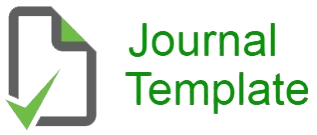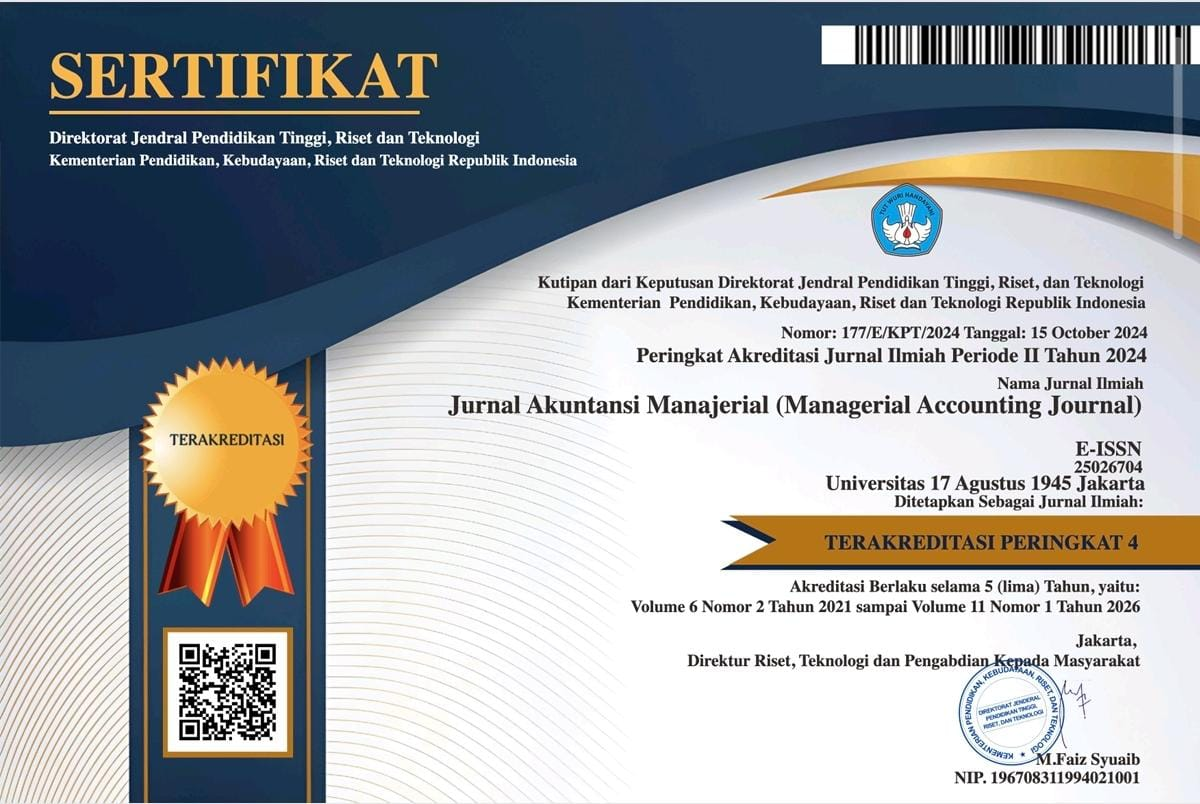EFEK PEMODERASIAN INDIKATOR MONETER TERHADAP VALIDITAS DARI TRADE-OFF THEORY DI BURSA EFEK INDONESIA (BEI)
Abstract
Keputusan manajemen berkaitan dengan pilihan alternatif pendanaan yang akan digunakan untuk pengembangan investasi, pelunasan hutang yang segera jatuh tempo ataupun untuk pembayaran dividen, merupakan keputusan keuangan yang sangat stategis karena berdampak terhadap kinerja keuangan perusahaan baik dalam jangka pendek maupun jangka panjang. Pengunaan hutang sebagai alternatif sumber pendanaan atau penerbitan saham baru, keduanya mempunyai konsekwensi yang berbeda bagi perusahaan. Pengunaan hutang akan berdampak langsung terhadap kinerja, likuiditas dan bisa berdampak terhadap kesulitan keuangan yang akhirnya berakibat pada likuidasi usaha. Disisi lain penerbitan saham berdampak terjadinya dilusi terhadap pemegang saham lama dan potensi turunnya harga pasar saham. Trade-off Theory merupakan teori struktur modal yang lazim digunakan manajemen dalam pengambilan keputusan pendanaan perusahaan. Model struktur modal berdasarkan teori tersebut mengunakan variabel internal perusahaan sebagai variabel bebas yang mempengaruhi struktur modal perusahaan dan tidak memasukan variabel ekternal khususnya indikator moneter kedalam model struktur modal perusahaan. Beberapa hasil penelitian berkaitan pengaruh indiktor moneter terhadap struktur modal perusahaan telah dilakukan dibanyak negara dan secara empiris terbukti mempunyai pengaruh terhadap struktur modal perusahaan. Berdasarkan hal tersebut, menarik untuk diteliti fenomena efek Pemoderasian Indikator Moneter Terhadap Validitas dari Trade-off Theory di Bursa Efek Indonesia. Tujuan dari penelitian ini adalah untuk mengetahui efek pemoderasian indikator moneter terhadap validitas dari trade-off theory di Bursa Efek Indonesia. Penelitian ini dirancang sebagai penelitiaan deskriptif dan verifikatif dengan mengunakan data sekunder.Penelitian terhadap emiten industry non-keuangan di Bursa efek Indonesia dengan periode pengamatan 2009 sampai 2013.Pemilihan calon anggota sampel mengunakan probability sampling dan metode pemilihan sampel menggunakan metode acak bertigkat proporsioanl. Pengujian model regresi dengan mengunakan model regersi panel yang mengunakan tiga pendekatan yaitu Pooled least square, Fixed effect dan Random Effect. Berdasarkan analisis terhadap model regersi, diperoleh hasil kesimpulan bahwa dari perbandingan arah koefisien yang diestimasikan menurut teori dengan hasil penelitian, menunjukan model struktur modal Trade-offtheory, tidak valid dalam menjelaskan pengaruh variable independen terhadap struktur modal perusahaan, dari empat variabel yang diestimasi hanya satu variabel yang hasilnya sesuai dengan estimasi.Hasil penelitian berkaitan variabel moderating tingkat bunga dan nilai tukar, hasil penelitian menunjukan bahwa variable tingkat bunga terbukti sebagai variable moderating murni yang memperkuat hubungan variabel pertumbuhan, profitabilitas resiko bisnis dan tax shield dengan struktur modal.
Keywords
Full Text:
PDF (Bahasa Indonesia)References
Alworth, J., and G. Arachi, (2000); The Effect of Taxes on Corporate Financing Decisions: Evidence from a Panel of Italian Firm; International Tax and Public Finance, Vol.8, pp353-376
Antoniou, Antonios,Yilmaz Guney and Krishna Paudya (2002); Determinants of Corporate Capital Structure: Evidence from European Countries; Department of Economics and Finance, University of Durham, 23-26 Old Elvet, Durham, DH13HY, UK.
Baskin, J. (1989); An Empirical Investigation of The Pecking Order Hypothesis ; Journal of Finance, Spring edition.
Baye, Michael R, (2006); Managerial Economic & Business Strategy, 5th edition, USA: Mcgraw-Hill International.
Bevan, A.A., J Danbolt, (2002); Capital Structure and Determinants in The UK – a Decompositional analysis; Applied Financial Economic, Vol 12, 55-66
Booth, L., Aivazian, V., Demirguc-Kunt, A.E and Maksimovic, V (2001); Capital Structures in Developing Countries; Journal of Finance, Vol 39, 857-878.
Burgman, Todd A, (1996); An Empirical Examination of Multinational Corporate Capital Structure; Journal of International Business Studies, Vol 27, pp. 553-570.
Cai, francis and Arvin Ghosh, (2003); Test of capital structure theory: A Binomial Approach; Journal of business and economics studies, Vol 9 N0.2, pp.20-32
Camara, Omar (2012); Capital Structure Adjustment Speed and Macroeconomic Conditions: U.S MNCs and DCs; Euro Journals Publishing.
Chen, C.R., Weiyu Guo and Vivek Mande (2006); Corporate Value, Managerial Stockholdings and Investment of Japanese Firms; Journal of International Financial Management and Accounting. Vol.17, No.1, pp. 29-51.
Choi, Young Rok, (2003); Taxes and Corporate Capital Structure; Journal of Business, University Of Missouri Columbia.
Dammon, W. (1988); Handbook of Child Psychology, The Fifth Edition; New York: Jhon Wiley and Son,Volume 1-4,
DeAngelo, H. and R.W. Masulis, (1980);Optimal Capital Structure Under Corporate and Personal Taxation;Journal of Financial Economics, Vol. 8, 3-29
Deesomsak, Rataporn, Krishna Paudyal and Gioia Pescetto (2004); The Determinants of Capital Structure: Evidence from the Asia Pacific Region: Durham University.
Dokko,Yoon (1989); Effects Unexpected Inflation on Wealth Redistribution and Stock Price : Test of The Nominal Contracting Hypothesis; Bureau of Economic and Business Administration, University of Illinois Urbana-Champaign.
Donaldson, G.(1991); Corporate Debt Capacity: A Study of Corporate Debt Policy and the Determination of Corporate Debt Capacity; Boston: Division of Research, Harvard School of Business Administration.
Ellija, Setyawan. (2004);Dampak Reformasi Pajak Tahun 2000 Pada Struktur Biaya, Pengeluaran Modal dan Profitabilitas Perusahaan (Studi pada perusahaan Manufaktur di Bursa Efek Jakarta). Tesis. Fakultas EkonomiUniversitas Diponegoro.
Euis dan Taswan (2002); Pengaruh Kebijakan Hutang Terhadap Nilai Perusahaan Serta Beberapa faktor Yang Mempengaruhinnya; Jurnal Bisnis dan Ekonomi.
Frank dan Vidham K. Goyal, (2009); Capital Structure Decisions : Which factors Are Reliability Important; Social Science Research Net Work.
Frederic, S Mishkin (2012); The Economics of Money, Banking and Financial Market, Business School Edition; Pearson series in Economics,Amozon.
Gajurel, D.P, (2005); Macroeconomic Influences on Corporate Capital Structure; Trubhuvan University, Kurtipur, Nepal
Gau, George W., and Ko Wang (1990); Capital Structure Decisions in Real Estate Investment; Areuea Journal, Vol.18 No.4
Gujarati, Damodar N and Dawn C. Porter, (2009); Basic Econometrics, Fifth Edition;McGraw-Hill International Editions
Harris, Milton and Arthur Raviv, (1991); The Theory of Capital Structure : Model Based on Agency Cost; The Journal of Finance, Vol XLV, N0.1, 451-471
Hoque, Ziaul Mohammad and Mohammad Zakir Hossain (2008); Flawed Interest Rate Policy and Loan Default: Experience from a developing country; International Review of Business Research Papers Vol.4 No.5 October –November Pp. 235-246
Homaifar, Ghassem, et al, (1994); An Empirical Model Of Capital Structure Some Of Evidence; Journal of Business Finance and Accounting Vol.21, pp1-14
Jalilvand, Abolhassan and Robert S Harris (1984); Corporate Behavior in Adjusting to Capital Structure and dividend Target: An Econometric Study; Journal of Finance, Vol.13 issue 1;pp. 45-127.
Jensen, Mickel C. and W. Meckling, (1976);Theory of The Firm:
Managerial Behavior, Agency Cost, and Ownership Structure;Journal of Finance Economics ,December, Vol.3; pp. 305-360
Jensen, Michael C. (1986); Agency Cost of Free Cash Flow, Corporate Finance andTake Overs; American Economics Review Vol. 76, No 2, pp.323-329.
Jensen, Michel C. and Clifford W Smith (1985); Stockholder, Manager, and Creditor Interests: Application of Agency Theory; Harvard Business School.
Ju, Nengjiu, Robert Parrino, Allen M. Poteshman, and Michael S. Weisbach., (2005); Horses and Rabbits? Trade-off Theory and Optimal Capital Structure”. Journal of Financial and Quantitative Analysis, Vol. 40, No.2, pp. 259-280.
Klein, L.S., Thomas J.O.B., Stephen R. Peters (2002); Debt vs Equity and Asymmetric Information: A Review; The Financial Review. Vol.37, pp.317-350.
Kraus, Alan., and Litzenberger, Robert H (1972); A State-Preference Model of Optimal Financial Leverage; Jounal finance, volume 28, issued4, pages 911-922.
Lakshmi Shyam-Sunder, Lakshmi and Myers, Steward, (1999): Testing static tradeo against pecking order models of capital structure;Journal of Financial Economics, Vol 51; pp.219-244
Leland, Hayne E., and David H. Pyle, (1977);Informational Asymmetries, Financial Structure, and Financial Intermediation;Journal of Finance, Vol. XXXII, No. 2, 371-387
Low, Pek Yee and Kung H. Chen (2004); Diversification and Capital Structure: Some International Evidence; Review of Quantitative Finance and Accounting, Vol.23, pp.55-71.
Mackie-Manson, Jeffrey, “Do Taxes Affect Corporate Financing Decisions” Journal of Finance, 1990.
Madura, Jeff. (1995);International Financial Management, Fourth edition;West Publishing Company, St Paul, New York.
Mao, Connie X. (2003); Interaction of Debt Agency Problems and Optimal Capital Structure: Theory and Evidence;Journal of Financial and Quantitative Analysis, Vol.38, No.2, pp.399-423.
Masulis, Ronald W. (1983); The Impact of Capital Structure Change on Firm Value:Some Estimates;The Journal of Finance, Vol XXXVIII, No. 1, pp.107-126.
McConnel, Jhon J., and Chris J. Muscarella,(1984); Corporate Capital Expenditure Decisions and Corporate Capital Expenditure Announcements; Purdue: Purdue University, Lavayette, Inc
Miller, M.H (1988); The Modigliani-Miller Proposition After Thirty Years;Journal of Economic Perspectives, Vol.2, pp.99-120.
Modigliani, F. and M. Miller (1958);The Cost of Capital, Corporation Finance and the Theory of Investment;The American Economic Review, Vol.48; pp 261-297.
Modigliani, F. and M. Miller (1963);Corporation income Taxes and The cost of Capital: A Correction; The American Economic Review, Vol.53; pp 433-443.
Myers Stewart.C., (1977), Determinants of Corporate Borrowing, Journal of Financial Economics 9, November, pp.147-176.
Myers, Stewart. C. (1984); The Capital Structure Puzzle;The Journal of Finance, Vol 39, No.3, pp.575-592.
Myers, Stewart. C., and Nicholas S Majluf (1984); Corporate Financing and Investment Decisions When Firms Have Information That Investors Do Not Have; Journal ofFinancial Economics, Vol 13, pp.187-221.
Nisa Fidyanti. (2003); Faktor-Faktor Yang Mempengaruhi Kebijakan Hutang Perusahaan; Jurnal Ekonomi, Manajemen dan Akuntansi”. Vol.1 Nomor 1 Januari.
Nopirin (1992); Ekonomi Moneter, Edisi ke Empat; BPFE Yogyakarta.
Ojah, Kalu and Justo Manrique (2005); Determinants of corporate debt structure in aprivately dominated debt market: a study of the Spanish capital market;Applied Financial Economics, Vol. 15, pp.455-468.
Ozkan, A., 2001; Capital Structure Choice and Adjustment to Long Run Target: Evidence from UK Company Panel Data; Journal of Business Finance & Accounting, Vol 28 (1) & (2), 175-198
Panno, A (2003); An Empirical Investigation on The Determinants of Capital Structure: the UK and Italian Experience; Applied Financial Economics, Vol 13, pp.97-112.
Pao, Hsiao Tien, and Yau Yu Chih, (2005); Comparison of Linear and Nonlinear Models for panel Data Forecasting: Debt Policy in Taiwan; Review of Pacific Basin Financial Markets and Policies, Vol.8 No.3, 525-541
Pawlina, Grzegorz and Luc Renneboog (2005); Is Investment-Cash Flow SensitivityCaused by Agency Costs or Asymmetric Information? Evidence from the UK; European Financial Management, Vol. 11, No.4, pp.483-513.
Rajan, Raghuram and Luigi Zingales (1995); What Do We Know about CapitalStructure? Some Evidence from International Data;The Journal of Finance, Vol. 1, No.5, pp.1421-1460.
Rataporn Deemsomsak, Krisnha Paudal, Gioia Pasceeto, (2004); The determinant of capital structure : Evidence from the Asia Pacific Region; Journal Multinational Mangement, Vol.14 (2004) pp 387-405
Ross, Stephen A. (2001);Essentials of Corporate Finance, Third edition , New York McGraw-Hill Companies.
Ross, Stephen A. (1977); The Determination of Financial Structure: The Incentive Signaling Approach ;Bell Journal of Economics and Management Science, Vol. 8, pp.23-40.
Ross, Stephen., Westerfield, Randolph., and Jaffe, Jeffrey,(2006); Corporate Finance 9Th Edition;McGraw-Hill.
Rubeinstein, Mark E. (1973); A Mean-Variance Synthesis of Corporate Finance Theory; Journal of Finance, Vol.28,No.1; pp.167-181.
Sayilgan, Guven., Hakan Karabacak, and Guray Kucukkocaoglu, (2006); The Firm Specific Determinants of Corporate Capital Structur: Evidence From Turlies Panel Data; Investment Management and Financial Inovation, Vol 3, issued3, 125-139.
Seftianne dan Ratih Handayani, (2011); Faktor-Faktor Yang Mempengaruhi Struktur Modal Pada Perusahaan Publik Sektor Manufaktur; Jurnal Bisnis dan Akuntansi, Vol.13, No.1;pp.39-56
Sekaran, Uma (2003); Research Methods For Business: A Skill Building Approach; John Wiley & Son, Singapored.
Shum, Pauline M, (1999); Tax and Corporate Debt Policy in Canada: An Empirical Investigation; Canadian Journal of Economics, Vol.29-3;pp.556-572.
Shyham-Sunder, L. and S. Myers,(1999); Testing Static Trade-off Against Pecking Order Model of Capital Structure; Journal of Financial economics, Vol.51;No.2: pp 219-244
Smart, Scott B., Megginson, William L., and Gitman, Lawrence J,(2004); Corporate Finance Second Edition;Harvard Business Publishing.
Stiglitz, Joseph E. (1969); A Re-Examination of the Modigliani-Miller Theorem; American Economic Review, Vol.59,No.5; pp. 784-793.
Strebulaev, Ilya A. (2003); Do Test of Capital Structure Theory Mean What They Say?;Job Market Paper, London Business School, pp.1-42.
Thies, C., and Klock, M, (1992); Determinants of capital structure; Review of Financial Economics, Vol.1; pp.40-52
Titman , (1988); Financial Market and Corporate Strategy; Irvin Professional Publishing, USA
Titman and wessels, (1998); The determinants of Capital Structure Choice; The Journal of Finance, Vol.43 No.1; pp.1-19
Tong, Guanqun., and Christoper J.Green, (2005); Packing Order or Trade-off hypothesis? Evidence on the capital structure of China Companies; Applied economics, Vol.37, pp.2179-2189.
Voulgaris, F., D. Asteriou, and G. Agiomirgianakis (2002), ”Capital structure, asset utilization, profitability and growth in the Greek manufacturing sector”. Applied Economics.Vol 34, pp.1379-1388.
Zhi Dong, (2011); Foreign Exchange Rate and Capital Structure Decision: A Study of New Zealand Listed Property Trust” 17th Pacific Rim Real Estate Society Comference Gold Coast, Australia, Januari 2011.
DOI: https://doi.org/10.52447/jam.v1i1.738
Refbacks
- There are currently no refbacks.






